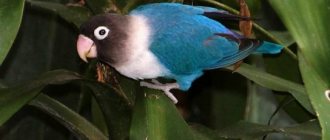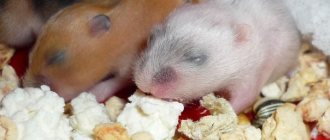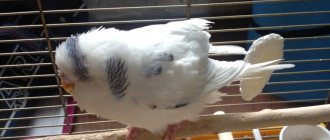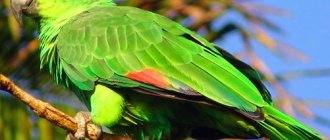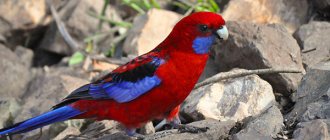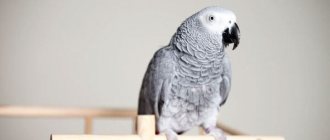We are accustomed to perceiving parrots as small birds chirping something in a cage. Meanwhile, the parrot family includes about 330 species, and they are all different in character, abilities, and plumage. There are bright and colorful birds, there are inconspicuous ones, talking, active or phlegmatic.
Some parrots are small, fitting in the palm of your hand, while others stand out for their size. Parrots immediately catch the eye because... It’s hard not to notice these bright, cheerful, temperamental birds.
Do you want to know which parrot is considered the largest in the world? We present you a rating of 10 large individuals: photos with descriptions of birds.
Blue Macaw
A magnificent bird of faded blue color, with a grayish head, its chest and belly are turquoise. Weighs about 400 g, body length - from 55 to 57 cm. Once lived in Brazil, on plains with bushes and isolated tall trees, in palm groves and forest plantations.
But now the blue macaw does not live in the wild. They remain only in collections. There is a chance to revive this species. But there is also a danger here, because... most birds are closely related, and this contributes to degeneration.
But the best ornithologists are working to save blue macaws, and they have already made significant progress. So, if by 2007 there were only 90 birds in private collections, then by 2014 it was possible to increase this number to 400-500.
Amazon blue-faced
An interesting name, which again speaks about the appearance of the head of this bird. The front of this parrot's head is painted bright blue. You may also notice that he has red spots in the neck or chest area.
The rest of the plumage is green, but slightly darker than the previous representative. The beak is slightly smaller, and from a distance it may look like a pigeon's. Can reach 49 centimeters in length. They live mainly on the islands of Lesser Antilia. This type of parrot received the title of national bird in the state of Saint Lucia.
Great white-crested cockatoo
A dazzling white bird with only yellow underwings and undertail. The legs and tail are grayish-black. On the head is a magnificent crest, which, when raised, forms a crown. It weighs about 600 g, the body length is from 45 to 50 cm, and the tail is 20 cm.
The large white-crested cockatoo prefers forests, mangroves, swamps, and cutting areas of the Moluccas archipelago.
It lives either in pairs or in a flock, which can include up to 50 individuals. These birds prefer to lead a sedentary lifestyle, but if there is not enough food, they can migrate.
Greater yellow-crested cockatoo
It can be found in Australia, New Guinea, and Tasmania. It grows up to 48-55 cm, weighs from 810 to 975 g, females are 35-55 g heavier than males. It is a beautiful white color with a hint of yellow. The beak is grayish, as are the paws. Prefers forests of eucalyptus and palm trees, savannas, close to water. Lives in flocks of 60-80 parrots.
Large yellow-crested cockatoos become active in the evening or early in the morning; during the day they prefer to rest in the shade and are excellent climbers. After lunch they prefer to take a nap. They feed on berries, buds, seeds, roots, and love tender grass sprouts.
At the end of the day, they congregate on lawns and can browse the grass for hours. They live up to 50 years. They are often kept at home. They cannot produce sounds, but they perform tricks well, which is why they can be found in the circus.
Moluccan cockatoo
The birds are white, but on the neck, head and belly there is a pink tint mixed with the white color, and the undertail is yellow with an orange tint, the underwings are also pink-orange. On the head there is a tuft 15 cm high. It grows up to 46-52 cm, weighs about 850 g. Lives in Indonesia.
Unfortunately, the number of Moluccan cockatoos is constantly declining due to illegal catching, as well as other unfavorable factors. Birds prefer tropical rainforests. They can live both in pairs and in a flock, which usually numbers no more than 20 individuals. Cautious, they prefer tall trees to live.
mourning cockatoo
As the name suggests, these birds are dark in color, with only a red stripe on the tail. The female has many yellowish-orange spots. There is a crest on the head. The mourning cockatoo reaches significant sizes: it grows up to 50-65 cm, weighs from 570 to 870 g. It lives in Australia, prefers eucalyptus forests, but can settle in acacia or casuarina plantings.
Once upon a time, flocks of parrots numbered up to 200 individuals, but now their groups do not exceed 3-8 birds. In the morning they go for water, and then search for food. At noon they hide in the trees, and in the evening they come out again in search of food. One of the birds of the flock often becomes a “scout”, i.e. looks for food and water for everyone, and, having discovered this, calls out to the others with a cry. Cockatoos feed on eucalyptus seeds, nuts, fruits, and can eat seeds.
It is considered one of the most expensive birds, the export of which is prohibited. They should not be bred at home, because... They are noisy, chew everything they can get their hands on and secrete copious amounts of powder to clean their plumage, which pollutes the house and can trigger an asthma attack.
The most decorative
Of the variety of species of these amazing birds, it is difficult to single out those that are particularly beautiful and graceful. Therefore, the division is rather arbitrary. But still, there are several breeds that can charm even the most sophisticated bird connoisseurs with their attractiveness.
Ozherelovy
The main color of these parrots is light, pastel green. Other colors have also been bred through selection, so you can often see white birds of this species or rainbow ones on sale. But the familiar necklace parrots have precisely the light green color of their feathers. Africa is considered the homeland of this species. Life expectancy is 20 – 30 years. How long a pet will live will depend on the conditions in which it is found.
It is considered a dimorphic species. Adult males have pink or black ring-shaped throat marks around their necks, while females do not have rings. Parrots are unpretentious in care and maintenance at home. There are only a few mandatory conditions that need to be met.
These are:
- cleaning the cage 2 times a week;
- balanced diet;
- daily washing of dishes from which the parrot takes food;
- the ability to fly short distances;
- communication with the owner.
On the last point, we can add that necklace parrots can be taught to speak. They willingly copy their owner's vocal habits, intonation and timbre. But representatives of this breed have a loud, ringing and rather harsh voice, so speech exercises do not always please its owner.
Collar
Having a green-blue color of feathers, parrots of this species are distinguished by a bright yellow “collar” around the neck. They were first discovered in Australia. The bird is very dynamic and freedom-loving. Parrots are great for keeping at home in a spacious enclosure - they simply need active flight. It is worth knowing that destroying a wooden enclosure will not be difficult for the winged beauty.
The diet of feathered pets should be varied:
- insects and their larvae;
- plants' seeds;
- cereals;
- vegetables;
- fruits.
Average life expectancy is 30 years. The collared parrot easily learns spoken language, but only up to three years of age. If the bird is older, then training is practically useless.
Mountain
The luxurious mountain parrot is distinguished by its extraordinary ingenuity. In their natural environment, they make their nests on ledges and in small caves of Australian rocks. Hence the name. The plumage of males is lemon yellow, and that of females is olive.
The mountain parrot has a loud voice. He screams often and shrilly, this is worth remembering when deciding to keep him at home. This bird needs to fly a lot to maintain physical health. Therefore, the cage for a captive bird should be spacious. They do not get along well in the same cage with representatives of other species. Sharing should be avoided. Unpretentious in nutrition. You can teach them to talk, but they are more amenable to training. These birds are real acrobats.
Black palm cockatoo
In New Guinea, Australia, and the Cape York Peninsula, you can find the black palm cockatoo . It grows up to 70-80 cm, plus a tail measuring 25 cm, weighs from 500 g to 1 kg.
It is black. It has a rather large and powerful beak, growing up to 9 cm, also black. The cheeks are meat-colored, sometimes becoming red-scarlet. Females are slightly smaller than males.
Prefers to live in savannas and tropical forests, alone or in groups. The black palm cockatoo climbs well on tree branches; if excited, it makes unpleasant, sharp sounds. Lives up to 90 years, keeping their pairs for life.
Everything you need to know about big parrots
When purchasing large birds, we must not forget about the peculiarities of breeding and maintenance. You need to consider the dimensions of your feathered pet and buy an aviary or cage. For Amazons and Grays, the size of the house should be at least 45x45x70 cm. Such cages are sold in pet stores. If the choice is a macaw or cockatoo of large varieties, you need an aviary for large species. Sometimes you cannot find a cage of a suitable size on the market, so you need to order it.
A cage or aviary is not all the needs of poultry. Large parrots need special toys. Perches, drinking bowls, feeders, and swings are also needed to spend time productively while the owner is away.
Red Macaw
Very beautiful parrots, painted predominantly in bright red, except for the uppertail and underwings, which are bright blue, only a yellow stripe runs across the wings. They have light cheeks with a row of white feathers. Their body length is from 78 to 90 cm, and they also have a luxurious tail of 50-62 cm. They weigh up to 1.5 kg. Its place of residence is Mexico, Bolivia, Ecuador, the Amazon River, prefers tropical forests, and chooses the crowns of tall trees to live.
The red macaw feeds on nuts, fruits, young shoots of bushes and trees, and often causes significant damage to plantations by eating crops. Once upon a time, Indians hunted them, ate their tasty meat, and made arrows and jewelry from their feathers. They live up to 90 years.
Content Highlights
If you still haven’t given up on the idea of acquiring a large winged friend, it’s worth learning about the basic aspects of care and maintenance so that your pet is as comfortable as possible with you.
Important! Statistics show that only a quarter of parrots survive to old age in captivity and die a natural death. The majority (60%) die as a result of improper care, disease and injury.
Cell
It is advisable to keep the largest representatives - macaws and cockatoos - in an aviary or a separate room. However, given that the pet will spend about 90% of its time outside the house, you can equip a cage for it.
Be sure to take into account not only the length of the body, but also the wingspan. For these breeds, the dimensions are as follows: 100*100*170 cm, for smaller varieties the parameters 65*50*80 cm are suitable.
The bars of the cage must be made of high-quality durable metal with a thickness of at least 4–5 mm, otherwise the parrot will easily damage or chew them. The cage must not be painted or galvanized. Also, take care of a reliable lock on the door - due to the bird’s natural intelligence, strength and curiosity, it will not be difficult for the bird to open the lock.
Accessories
In addition to the cage itself, you need to purchase many more accessories:
- Feeder. Can be external or internal. It is advisable to choose feeders made of high-quality and durable stainless metal.
- Wooden perches and squats. They are available on sale from a variety of materials (textiles, pumice, cement, plastic), but wood is preferable because of its safety and environmental friendliness. Keep in mind that parrots simply love to chew on them, so be prepared to replace several perches every day and remove splinters of broken wood underneath them. Therefore, it is better (more economical) to make them yourself.
- Drinking bowl. Must be placed inside the cage. You cannot use open drinking bowls, because the water in them will immediately become contaminated with droppings. It is better to opt for vertical containers with a pocket at the lower end.
- Mineral stone. Necessary to meet the body's needs for micro- and macroelements. Attached inside the cage.
- Toys. A large number and variety of toys will not allow your pet to get bored and will reduce the likelihood of damage to prohibited (valuable) items in the house.
- Net. Required to catch the parrot until you tame it.
- Taming stick. It looks like a long plastic pole (100 cm) with a fork at the end. Fruits are placed on it and offered to the bird. By gradually reducing the distance from the fruit to the palm, you can tame your pet.
Blue and yellow macaw
A very bright, magnificent parrot of a bright blue color, whose chest and belly are a bright yellow, with an orange tint, and a black throat. Forehead is green. The beak is also black, very powerful and strong. With its help, the blue-and-yellow macaw can gnaw tree branches and shell nuts.
Screams loudly and harshly. Inhabits the tropical forests of Brazil, Panama, Paraguay, choosing river banks for life. Its body length is 80-95 cm, weighs from 900 to 1300 g.
Hyacinth macaw
The parrot is a beautiful cobalt blue color with a gray, bluish long and narrow tail. This is one of the largest parrots, which grows up to 80-98 cm and weighs up to 1.5 kg. The hyacinth macaw screams very loudly, making a guttural, sharp sound, sometimes a hoarse squeal, which can be heard at a distance of 1-1.5 km.
They live in the outskirts of the forest, in swampy places in Brazil, Paraguay, and Bolivia. They live in small flocks of 6-12 individuals, eating palm nuts, fruits, fruits, berries, and aquatic snails. They are endangered. In 2002 there were about 6,500 individuals.
Where can I buy an exotic bird?
any exotic birds, especially large ones, in nurseries from professional breeders. They will provide documentary evidence of the breed, vaccinations received and examinations by a veterinarian. You can find breeders on specialized forums or by looking through message boards.
Buying exotic birds at the poultry market is fraught with serious consequences. The bird may turn out to be out of breed, elderly and with a whole bunch of diseases.
As for the price, it varies widely, depending on the subspecies of the bird, its age, skills and the pricing policy of the breeder. For example, a young white cockatoo can be bought for 30,000 rubles, a large yellow-crested one for 100,000, and a hyacinth macaw will cost 1.5 million rubles.
Owl parrot
Its other name is kakapo . This is one of the oldest living birds, native to New Zealand. She has yellow-green plumage, speckled with black. The beak is gray and significant in size.
The owl parrot cannot fly and prefers to be nocturnal. The body length is relatively small - 60 cm, but in adulthood it weighs from 2 to 4 kg. Prefers forests where there is high humidity, lives on the ground.
During the day it hides in a hole or rock crevices, at night it looks for food - berries or plant juice. If desired, it can climb to the top of a tree and jump from it, using its wings like a parachute.
7 1
